You are using an out of date browser. It may not display this or other websites correctly.
You should upgrade or use an alternative browser.
You should upgrade or use an alternative browser.
Not Exactly Pickelhaubes. British Grenadier Mitre Caps ?
- Thread starter newbe
- Start date
oldhelmets
New member
would you like to save mr green's life? Sell it to me or trade it to me. I know the very consevationist who can save him. It'll be rather bank breaking though
Gents
I sent Mr Green to Cameron Laughlin for Turner, Laughlin & Associates, Ltd. for restoration. Please find attached his report and photographs.
You will recall he was an e_bay find and in very poor condition.
I wish to record my thanks and apprecition to Cameron for a splendid job and members of this forum for recommending him otherwise he may have just crumbled away
Cameron's research indicate that this mitre is one of perhaps a dozen known original British Army examples dating to the eighteenth century.
Of that number, few are enlisted versions, and no other examples from the Queen's Own Regiment appear to have survived.
Classic British military mitre, worn by a member of the Grenadier Company, 2nd “Queen's Own” Regiment of Foot, manufactured between 1727 and 1743.
Date: 30 May 2013
Artifact Provenance: eBay purchase; no accompanying information
Inferred Provenance: see Artifact Interpretation
Artifact Description: Green woolen mitre, with extensive, artful hand embroidery, woolen lace, woolen soutache, and puff-pompon. Body is constructed of an almost lime-green, doeskin-finished facing wool, of high quality. Embroidery is executed in off-white cable-laid silk upon a cardstock cutout base/filler to add relief. Frontal ornamentation consists of a British imperial crown, flanked by scrollwork; a blue woolen applique representation of the Order of the Garter with embroidered motto “Honi Soit Qui Mal Pense,” bordered by lemon yellow soutache, and with a scarlet woolen circular center bearing the silk-embroidered initials “CR;” a lower panel of scarlet wool bordered by tubular woolen lace, bearing the embroidered motto “Nec Aspera Terrent” and bordering—on three sides—an embroidered representation of a galloping horse. Rear ornamentation consists of a bottom panel with more high-relief scrollwork, and black-bordered off-white woolen flat lace covering all sewn seams. Pompon is of off-white woolen yarn, with no core, stitched at mitre's apex. Cap's interior is a mass of sheet cork fragments, shredded polished cotton, and two types of disintegrating cotton sateen. Condition overall is poor. All woolen fabric and embroideries are infused with and discolored by coal dust and other particulates, and most seams are coming apart. Some color bleeding from scarlet lower panels. Woolen lace is shredded at high points and in many other areas, with a patch of lace entirely missing above the “Nec Aspera” motto. Interior is a near-incomprehensible and filthy mass of fragments and shreds.
All original seams--both structural and for affixing ornamentation--are handsewn with both silk and cotton thread. Some seams on replacement components (see Artifact Interpretation) are handstitched, while others were executed on a sewing machine. The cap's structure and layout points to subcontracted work, including professional embroidery followed by inexpert cottage assembly. The latter manufacture was tackled by one who was likely numerically illiterate: nothing in the cap's assembly is symmetrical, and all measurements appear to have been “eyeballed.”
Artifact Interpretation: Classic British military mitre, worn by a member of the Grenadier Company, 2nd “Queen's Own” Regiment of Foot, manufactured between 1727 and 1743. Reid and Hook in British Redcoat, 1740-1793 (London: Reed Books, [Osprey Warrior Series], 1996) offer a nutshell view of the martial mitre's development: “Originally the mitre was simply a stocking cap with a small turn-up at front and rear--the 'little flap,' but by the 1740s the whole cap was stitched together and a degree of stiffening provided for the now combined front and 'little flap,' in order that the cap stood upright. It appears, however, that this attempt to smarten it up was frustrated by the grenadiers'
Date: 30 May 2013
Artifact Provenance: eBay purchase; no accompanying information
Inferred Provenance: see Artifact Interpretation
Artifact Description: Green woolen mitre, with extensive, artful hand embroidery, woolen lace, woolen soutache, and puff-pompon. Body is constructed of an almost lime-green, doeskin-finished facing wool, of high quality. Embroidery is executed in off-white cable-laid silk upon a cardstock cutout base/filler to add relief. Frontal ornamentation consists of a British imperial crown, flanked by scrollwork; a blue woolen applique representation of the Order of the Garter with embroidered motto “Honi Soit Qui Mal Pense,” bordered by lemon yellow soutache, and with a scarlet woolen circular center bearing the silk-embroidered initials “CR;” a lower panel of scarlet wool bordered by tubular woolen lace, bearing the embroidered motto “Nec Aspera Terrent” and bordering—on three sides—an embroidered representation of a galloping horse. Rear ornamentation consists of a bottom panel with more high-relief scrollwork, and black-bordered off-white woolen flat lace covering all sewn seams. Pompon is of off-white woolen yarn, with no core, stitched at mitre's apex. Cap's interior is a mass of sheet cork fragments, shredded polished cotton, and two types of disintegrating cotton sateen. Condition overall is poor. All woolen fabric and embroideries are infused with and discolored by coal dust and other particulates, and most seams are coming apart. Some color bleeding from scarlet lower panels. Woolen lace is shredded at high points and in many other areas, with a patch of lace entirely missing above the “Nec Aspera” motto. Interior is a near-incomprehensible and filthy mass of fragments and shreds.
All original seams--both structural and for affixing ornamentation--are handsewn with both silk and cotton thread. Some seams on replacement components (see Artifact Interpretation) are handstitched, while others were executed on a sewing machine. The cap's structure and layout points to subcontracted work, including professional embroidery followed by inexpert cottage assembly. The latter manufacture was tackled by one who was likely numerically illiterate: nothing in the cap's assembly is symmetrical, and all measurements appear to have been “eyeballed.”
Artifact Interpretation: Classic British military mitre, worn by a member of the Grenadier Company, 2nd “Queen's Own” Regiment of Foot, manufactured between 1727 and 1743. Reid and Hook in British Redcoat, 1740-1793 (London: Reed Books, [Osprey Warrior Series], 1996) offer a nutshell view of the martial mitre's development: “Originally the mitre was simply a stocking cap with a small turn-up at front and rear--the 'little flap,' but by the 1740s the whole cap was stitched together and a degree of stiffening provided for the now combined front and 'little flap,' in order that the cap stood upright. It appears, however, that this attempt to smarten it up was frustrated by the grenadiers'
Significantly, the milliners also trimmed away the now-excess original green and scarlet fabric--a band perhaps 3/4” wide--along the cap's bottom as part of this effort at symmetry. After the reconstruction, most of the cap's wear--including some bleeding of the non-colorfast scarlet fabric at the mitre's bottom (positioned against a wearer's brow)--appears to have occurred in this period of secondary use.
Tertiary use was evidently as a display item, likely in a home, then retirement to storage. And these dispositions occasioned a final, superficial modification to the mitre, plus more deterioration. Perhaps sometime after Victoria's reign, the cap's cork stiffening began to disintegrate--which is typical for aged sheets of this material. As a stopgap, evidently in an attempt to keep cork fragments from littering the home's mantlepiece, someone who was not adept at sewing handstitched a short black cotton sateen bag to the mitre's lower edge. (By the time the cap was received for treatment, this century-old addition had also begun to fall apart). Once the cap became too disreputable for display, it was retired to an attic or basement in a structure utilizing coal for heating. Lying face-up on a horizontal surface, the mitre became infused with coal dust and soot, permanently discoloring all surfaces--but especially its front. The presence of sulfuric acid in this environment faded the bright green and rotted the cap's handstitched seams, as well as the stitching securing lace trim. Too, it appears to have rendered the single layer lace brittle, and prone to disintegration. Remarkably, the woolen facing fabric, as well as the woolen yarn pompon remained rot-free, though discolored.
When examined for treatment, and especially once the several layers of intrusive lining were removed, it became readily apparent that the only possible course for restoration and reconstruction would be separation of the cap into its component parts and complete rebuilding--in as gentle and unobtrusive a fashion as possible.
Treatment Details
Note: All materials employed in conservation and reconstruction were of museum/archival quality, including filtered water, and pH-neutral soaps, paints, varnishes, and adhesives. All thread used in restoring the cap was pure cotton and silk, usually of pre-WWII vintage. Wherever use of materials is mentioned, we will avoid redundancy, and permit the reader to infer “archival quality” or “pH neutral.”
Condition: Cap interior littered with cotton fabric swatches and cork fragments.
Action: Remove all intrusions, documenting the removal of layers via photography, and archiving the salvaged materials for retention by owner.
Condition: Thread securing structural seams rotten, seams failing.
Action: Remove remaining threads and disassemble cap. Archive all retrieved thread fragments.
Condition: Thread securing ornaments is rotten, appliques and lace are in danger of falling off cap.
Action: Remove ornaments and pompon, archive thread fragments, and document disassembly with photographs.
Condition: All components soiled with coal dust and other contaminants.
Action: Test for colorfastness. Handwash colorfast green woolen fabric and undyed pompon with pure soap and rinse. Rinse non-colorfast fabrics, including the scarlet and blue facing materials in mineral spirits. Note: multiple rinsings were employed, whether of filtered water or mineral spirits.
Condition: Regimental lace--consisting of a 3/8” off-white woolen strip, bordered on one side with a woven-in black yarn “worm” on one edge—is tattered, frayed, and incapable of consolidation or longterm preservation. [Owner consulted.]
Action: Craft replacement lace, of authentic 100% woolen tape, bordered with handstitched black Angora yarn, and overdye a light pearl gray to match the color of other previously-white components.
Condition: Lemon yellow soutache bordering Order of the Garter insignia disintegrated upon removal from cap.
Action: Overdye replacement soutache of authentic 100% wool in correct lemon yellow hue.
Condition: Tubular lace bordering “Nec Aspera” motto frayed in several locations; missing portion at right, above running horse.
Action: Secure frayed portions with extensive handstitching; add patch of original nineteenth century tubular lace.
Condition: All structural and ornamental components now separate.
Action: Handsew ornamentation to front panel. Handstitch the cap's three main panels together, using original stitch-holes wherever possible, and notes on sewing patterns and stitch lengths taken at time of disassembly. Handsew regimental lace atop seams. Handstitch pompon at cap's apex.
Condition: Fabric missing at base of front panel (cut away as part of the nineteenth century reconstruction).
Action: Salvage green fabric from seam overlap of upper rear panel with lower; trim and transplant to cap front's lower edge. Secure with handsewn blind seam, backed with woolen tape. Use scarlet fabric salvaged from a nineteenth century British uniform to extend running horse and “Nec Aspera” panels; blindstitch and back, as with the green facing material. Replace salvaged fabric at seam with new.
Condition: Mitre's original strawboard-and-cane stiffening frame removed during nineteenth century reconstruction. Materials substituted at that time now disintegrated.
Action: Construct replacement frame of museum board (a pH-neutral substitute for the original, highly acidic strawboard) and Spanish cane. Use woolen panel dimensions, seams, and wear patterns as a guide for this construction's dimensions. Paint finished frame with acrylics, then create an acid barrier via application of four coats of Polyurethane varnish. Friction-fit frame within mitre. Note: Although it seems strange the the top two inches of lace-covered side-seams are concealed behind the front panel's apex, this placement is mandated by the shapes and placements dictated by original seams and wear patterns. In short, this is exactly how the original appeared.
Condition: Lining.absent.
Action: Construct lining of vintage natural Belgian linen, of appropriate weight and weave, handwashed before use. Handstitch in place with running stitch around perimeter using vintage linen thread. Note: the lining's two structural seams and single dart were machine-sewn with cotton-wrapped polyester thread in a blindstitch, to avoid any potential for confusion by future examiners.
Final Action: Steam, bone, and towel overall.
Photography: All actions were extensively photographed. Compact disk is included with this report.
References: After extensive research, it eventually became apparent that eighteenth century British mitres are poorly documented and no contemporary scholar could be classed as expert in the topic. A very brief but helpful article by Robert Henderson, titled “The British Grenadiers and Their Mitre Caps” is readily available through several sources online, and appears to contain no factual errors or assumptions. The same cannot be said of Matthew Keagle's paper, “This is the Cap of Honor,” presented at the Material Matters Conference. Also easily accessed online, this piece is a pseudo-academic take on the topic, which borders on the absurd in some of its assumptions and claims. The previously-cited work, British Redcoat, contains some additional discussion and fine illustrations of mitres and the uniforms with which they were worn. Too, an online survey of Google's “Images of British Grenadier Mitres” is instructive. The very few remaining examples of this type--several of which are militia, and most of which are officers'--provide interesting comparisons. The various reproductions depicted online appear to be universally bad.
Artifact's Significance: Our researches indicate that this mitre is one of perhaps a dozen known original British Army examples dating to the eighteenth century. Of that number, few are enlisted versions, and no other examples from the Queen's Own Regiment appear to have survived. Too, the fact that this restoration project entailed complete disassembly of an original cap enabled rare opportunities for study. This documentation--pertinent especially to the construction of accurate reproductions--is now housed in the Turner, Laughlin & Associates archive.
Conservation Recommendations: Given this piece's extreme rarity, physical security--protection against theft--assumes more significance than is typically the case. Aside from this protection, every effort has been made to ensure that this mitre survives for another two or three centuries. So long as the usual cautions about lighting, handling, and fluctuations in temperature and humidity are observed, this piece should require no maintenance into the indefinite future.
BEFORE
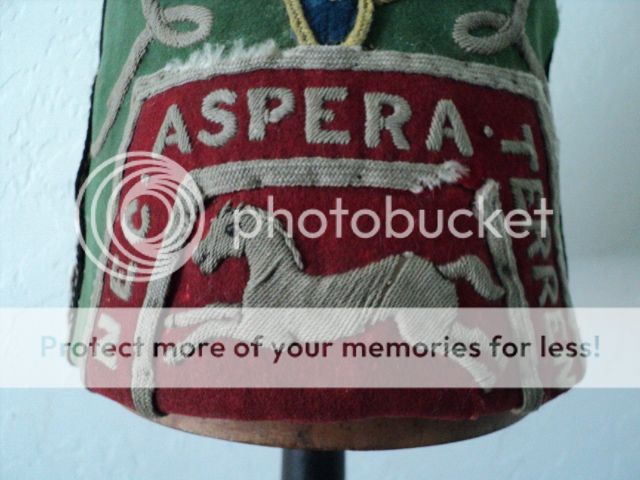
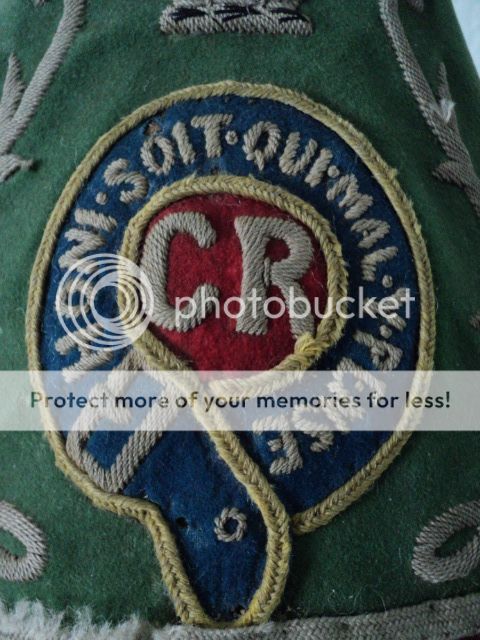

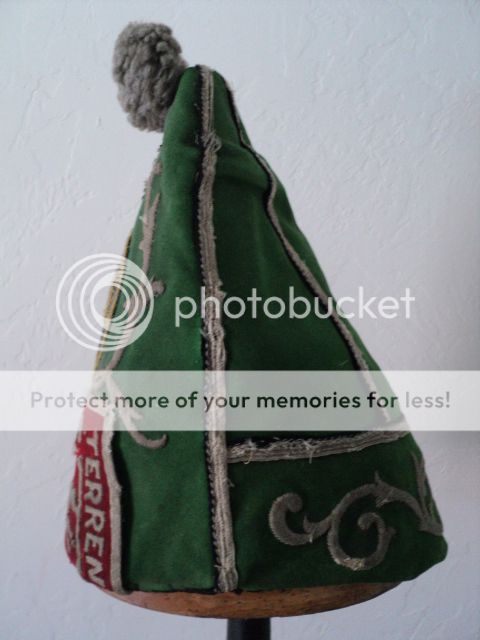
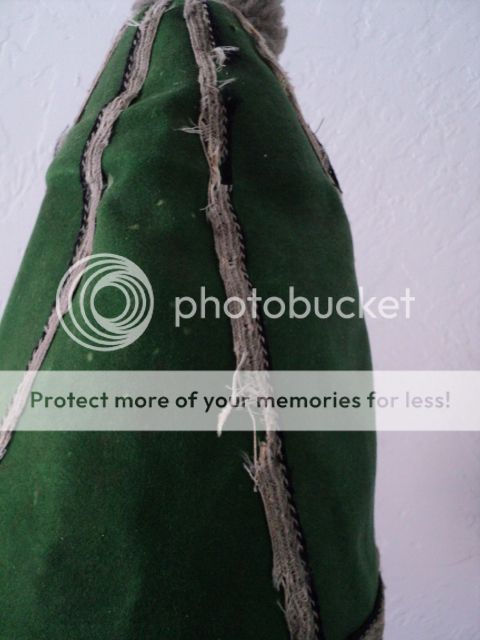
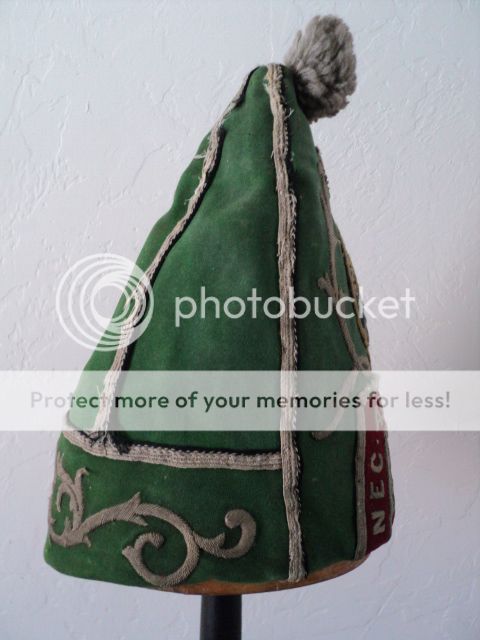
DISSECTION
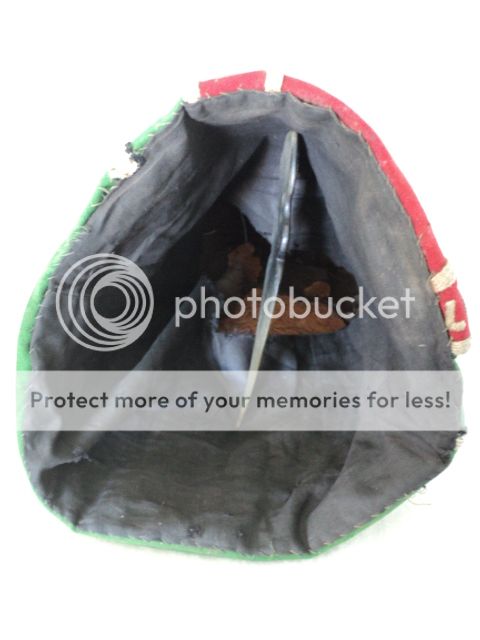
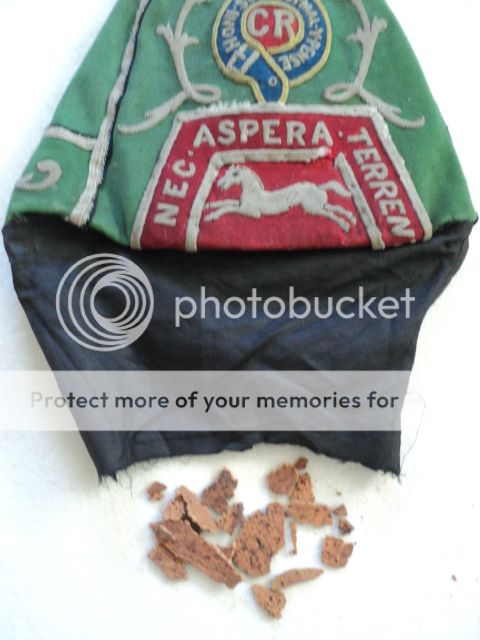
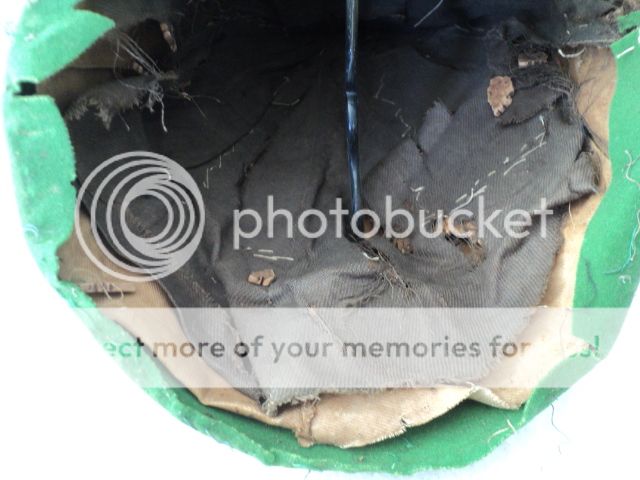
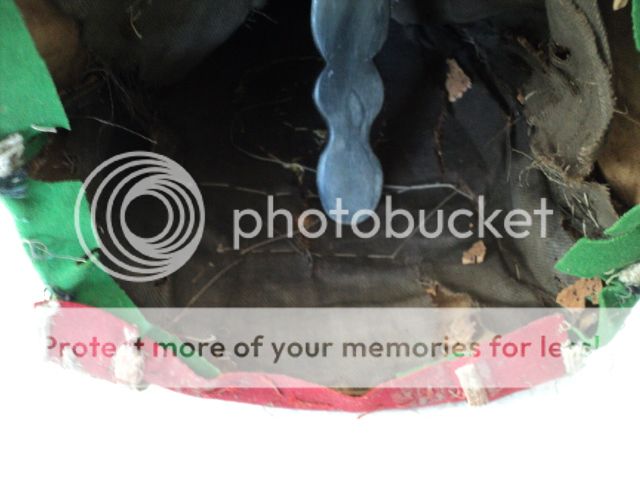
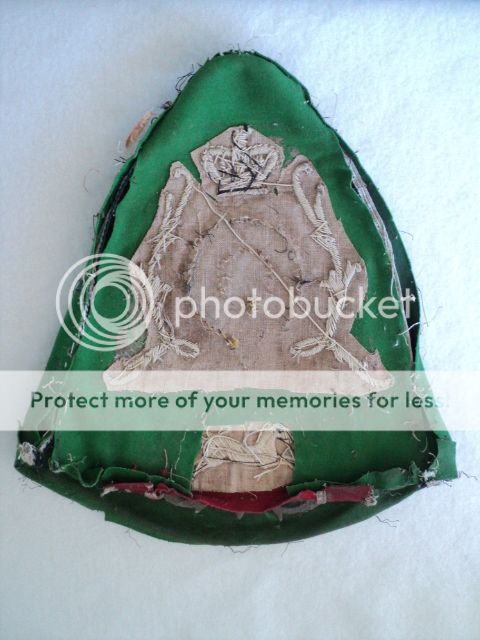
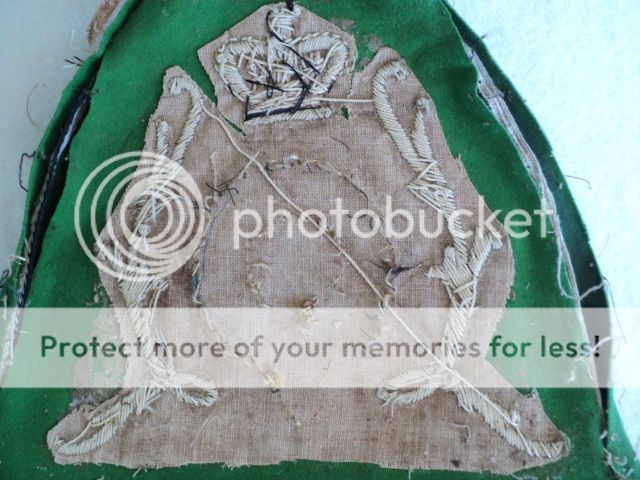
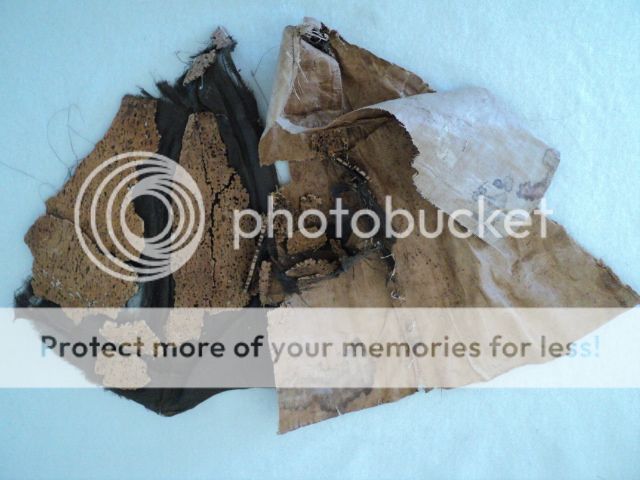
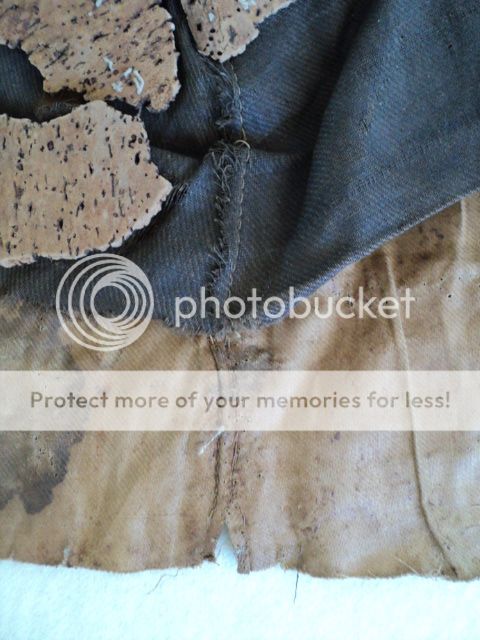
RESTORATION
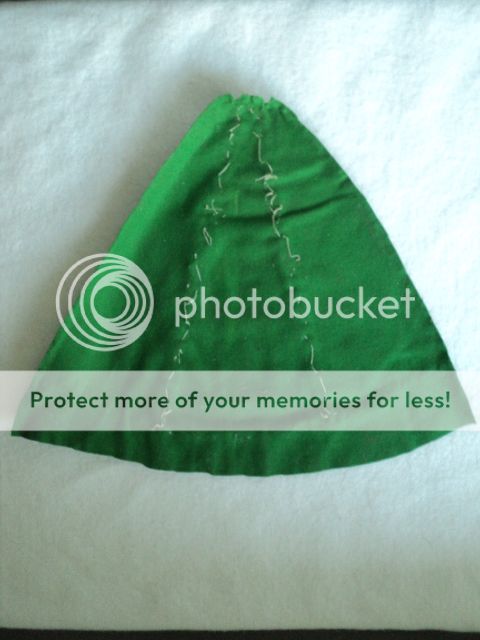
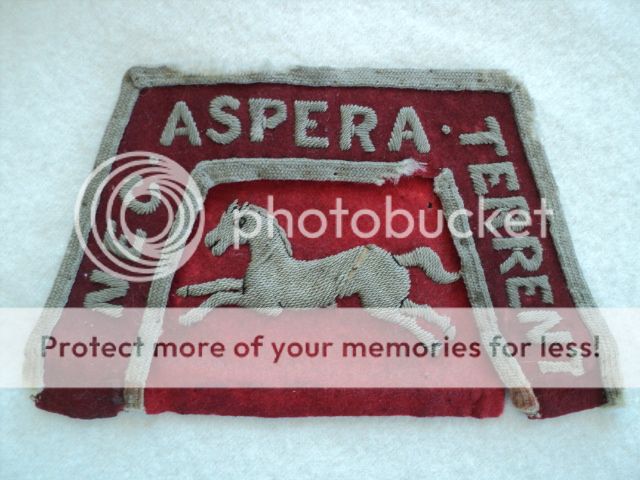
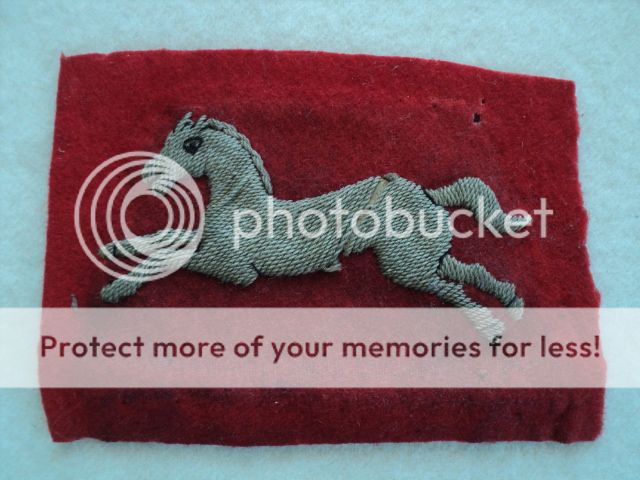
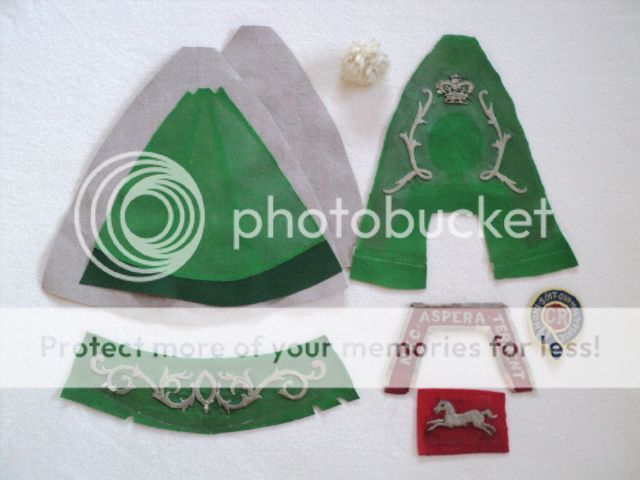
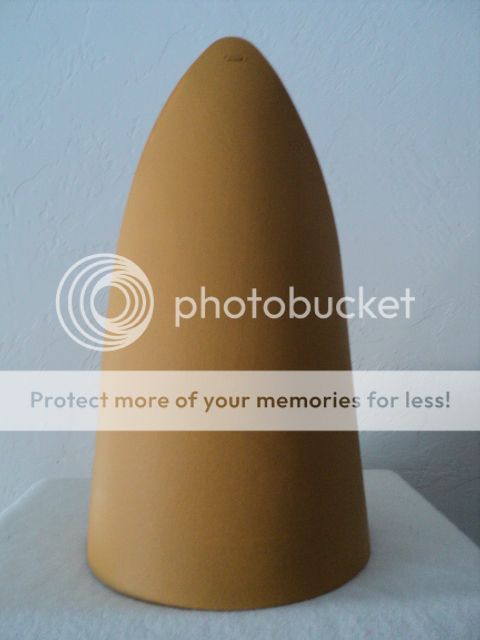
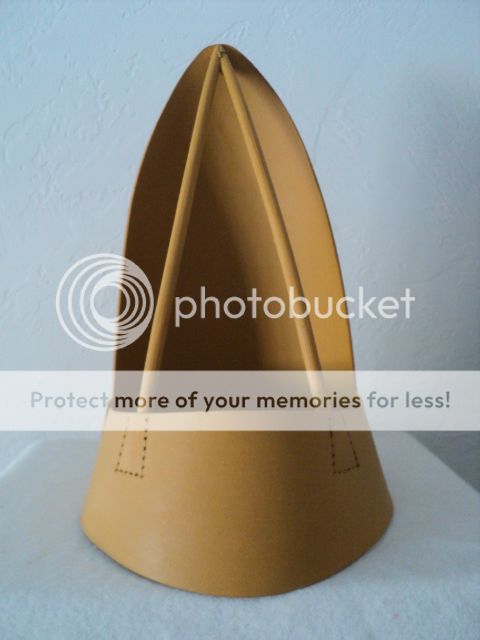
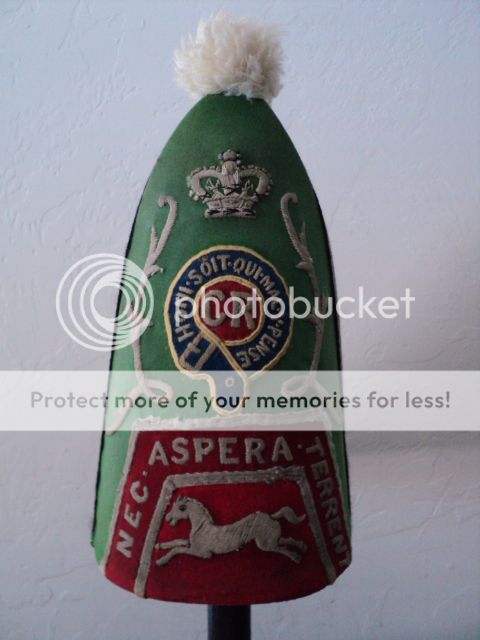
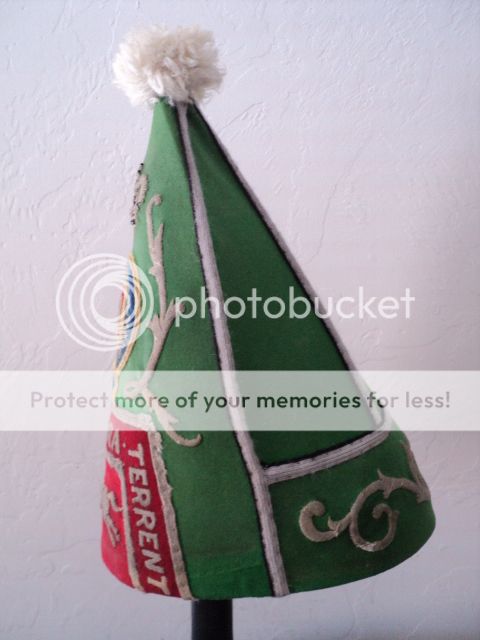
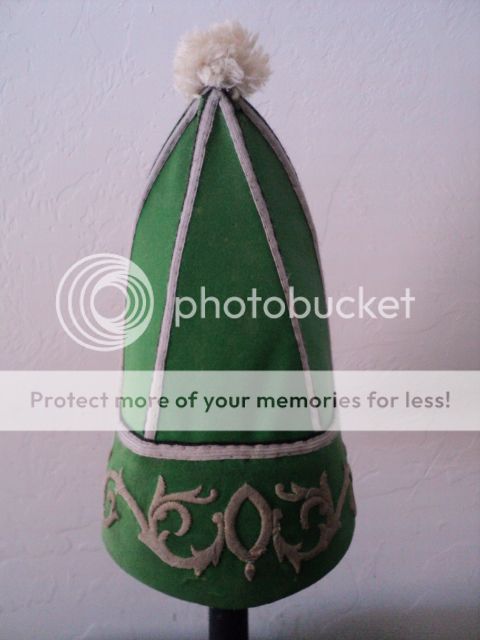
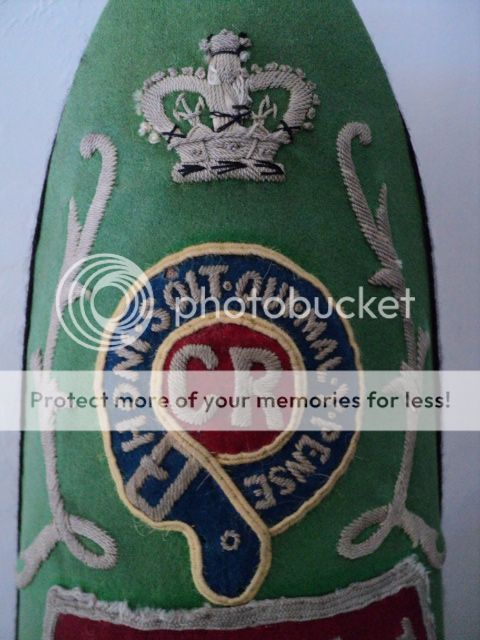
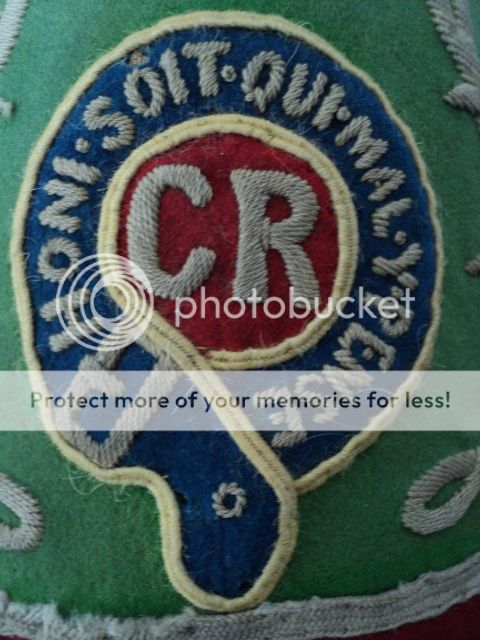
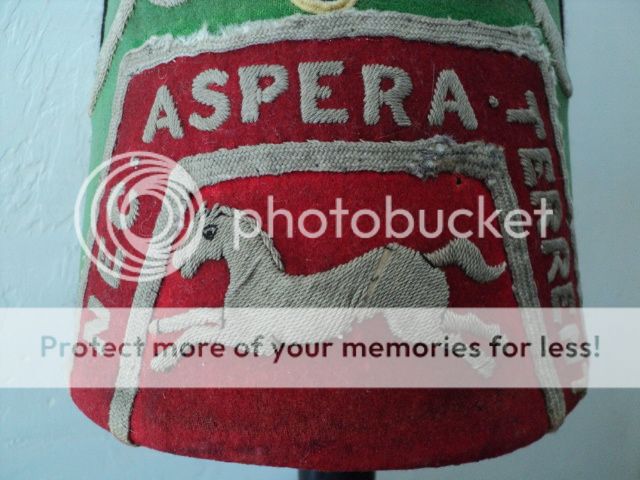
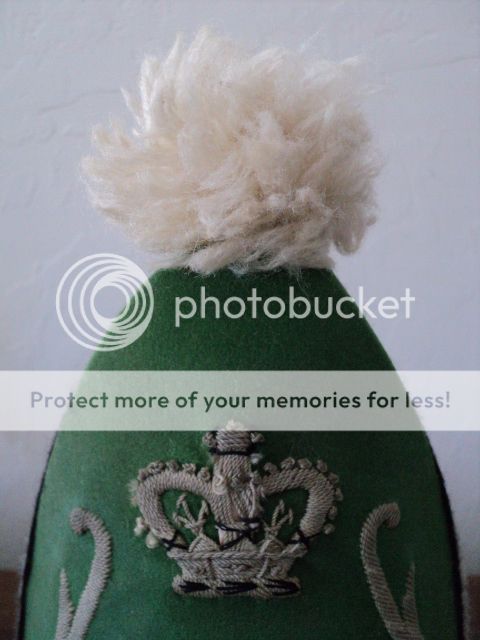
I sent Mr Green to Cameron Laughlin for Turner, Laughlin & Associates, Ltd. for restoration. Please find attached his report and photographs.
You will recall he was an e_bay find and in very poor condition.
I wish to record my thanks and apprecition to Cameron for a splendid job and members of this forum for recommending him otherwise he may have just crumbled away
Cameron's research indicate that this mitre is one of perhaps a dozen known original British Army examples dating to the eighteenth century.
Of that number, few are enlisted versions, and no other examples from the Queen's Own Regiment appear to have survived.
Classic British military mitre, worn by a member of the Grenadier Company, 2nd “Queen's Own” Regiment of Foot, manufactured between 1727 and 1743.
Date: 30 May 2013
Artifact Provenance: eBay purchase; no accompanying information
Inferred Provenance: see Artifact Interpretation
Artifact Description: Green woolen mitre, with extensive, artful hand embroidery, woolen lace, woolen soutache, and puff-pompon. Body is constructed of an almost lime-green, doeskin-finished facing wool, of high quality. Embroidery is executed in off-white cable-laid silk upon a cardstock cutout base/filler to add relief. Frontal ornamentation consists of a British imperial crown, flanked by scrollwork; a blue woolen applique representation of the Order of the Garter with embroidered motto “Honi Soit Qui Mal Pense,” bordered by lemon yellow soutache, and with a scarlet woolen circular center bearing the silk-embroidered initials “CR;” a lower panel of scarlet wool bordered by tubular woolen lace, bearing the embroidered motto “Nec Aspera Terrent” and bordering—on three sides—an embroidered representation of a galloping horse. Rear ornamentation consists of a bottom panel with more high-relief scrollwork, and black-bordered off-white woolen flat lace covering all sewn seams. Pompon is of off-white woolen yarn, with no core, stitched at mitre's apex. Cap's interior is a mass of sheet cork fragments, shredded polished cotton, and two types of disintegrating cotton sateen. Condition overall is poor. All woolen fabric and embroideries are infused with and discolored by coal dust and other particulates, and most seams are coming apart. Some color bleeding from scarlet lower panels. Woolen lace is shredded at high points and in many other areas, with a patch of lace entirely missing above the “Nec Aspera” motto. Interior is a near-incomprehensible and filthy mass of fragments and shreds.
All original seams--both structural and for affixing ornamentation--are handsewn with both silk and cotton thread. Some seams on replacement components (see Artifact Interpretation) are handstitched, while others were executed on a sewing machine. The cap's structure and layout points to subcontracted work, including professional embroidery followed by inexpert cottage assembly. The latter manufacture was tackled by one who was likely numerically illiterate: nothing in the cap's assembly is symmetrical, and all measurements appear to have been “eyeballed.”
Artifact Interpretation: Classic British military mitre, worn by a member of the Grenadier Company, 2nd “Queen's Own” Regiment of Foot, manufactured between 1727 and 1743. Reid and Hook in British Redcoat, 1740-1793 (London: Reed Books, [Osprey Warrior Series], 1996) offer a nutshell view of the martial mitre's development: “Originally the mitre was simply a stocking cap with a small turn-up at front and rear--the 'little flap,' but by the 1740s the whole cap was stitched together and a degree of stiffening provided for the now combined front and 'little flap,' in order that the cap stood upright. It appears, however, that this attempt to smarten it up was frustrated by the grenadiers'
Date: 30 May 2013
Artifact Provenance: eBay purchase; no accompanying information
Inferred Provenance: see Artifact Interpretation
Artifact Description: Green woolen mitre, with extensive, artful hand embroidery, woolen lace, woolen soutache, and puff-pompon. Body is constructed of an almost lime-green, doeskin-finished facing wool, of high quality. Embroidery is executed in off-white cable-laid silk upon a cardstock cutout base/filler to add relief. Frontal ornamentation consists of a British imperial crown, flanked by scrollwork; a blue woolen applique representation of the Order of the Garter with embroidered motto “Honi Soit Qui Mal Pense,” bordered by lemon yellow soutache, and with a scarlet woolen circular center bearing the silk-embroidered initials “CR;” a lower panel of scarlet wool bordered by tubular woolen lace, bearing the embroidered motto “Nec Aspera Terrent” and bordering—on three sides—an embroidered representation of a galloping horse. Rear ornamentation consists of a bottom panel with more high-relief scrollwork, and black-bordered off-white woolen flat lace covering all sewn seams. Pompon is of off-white woolen yarn, with no core, stitched at mitre's apex. Cap's interior is a mass of sheet cork fragments, shredded polished cotton, and two types of disintegrating cotton sateen. Condition overall is poor. All woolen fabric and embroideries are infused with and discolored by coal dust and other particulates, and most seams are coming apart. Some color bleeding from scarlet lower panels. Woolen lace is shredded at high points and in many other areas, with a patch of lace entirely missing above the “Nec Aspera” motto. Interior is a near-incomprehensible and filthy mass of fragments and shreds.
All original seams--both structural and for affixing ornamentation--are handsewn with both silk and cotton thread. Some seams on replacement components (see Artifact Interpretation) are handstitched, while others were executed on a sewing machine. The cap's structure and layout points to subcontracted work, including professional embroidery followed by inexpert cottage assembly. The latter manufacture was tackled by one who was likely numerically illiterate: nothing in the cap's assembly is symmetrical, and all measurements appear to have been “eyeballed.”
Artifact Interpretation: Classic British military mitre, worn by a member of the Grenadier Company, 2nd “Queen's Own” Regiment of Foot, manufactured between 1727 and 1743. Reid and Hook in British Redcoat, 1740-1793 (London: Reed Books, [Osprey Warrior Series], 1996) offer a nutshell view of the martial mitre's development: “Originally the mitre was simply a stocking cap with a small turn-up at front and rear--the 'little flap,' but by the 1740s the whole cap was stitched together and a degree of stiffening provided for the now combined front and 'little flap,' in order that the cap stood upright. It appears, however, that this attempt to smarten it up was frustrated by the grenadiers'
Significantly, the milliners also trimmed away the now-excess original green and scarlet fabric--a band perhaps 3/4” wide--along the cap's bottom as part of this effort at symmetry. After the reconstruction, most of the cap's wear--including some bleeding of the non-colorfast scarlet fabric at the mitre's bottom (positioned against a wearer's brow)--appears to have occurred in this period of secondary use.
Tertiary use was evidently as a display item, likely in a home, then retirement to storage. And these dispositions occasioned a final, superficial modification to the mitre, plus more deterioration. Perhaps sometime after Victoria's reign, the cap's cork stiffening began to disintegrate--which is typical for aged sheets of this material. As a stopgap, evidently in an attempt to keep cork fragments from littering the home's mantlepiece, someone who was not adept at sewing handstitched a short black cotton sateen bag to the mitre's lower edge. (By the time the cap was received for treatment, this century-old addition had also begun to fall apart). Once the cap became too disreputable for display, it was retired to an attic or basement in a structure utilizing coal for heating. Lying face-up on a horizontal surface, the mitre became infused with coal dust and soot, permanently discoloring all surfaces--but especially its front. The presence of sulfuric acid in this environment faded the bright green and rotted the cap's handstitched seams, as well as the stitching securing lace trim. Too, it appears to have rendered the single layer lace brittle, and prone to disintegration. Remarkably, the woolen facing fabric, as well as the woolen yarn pompon remained rot-free, though discolored.
When examined for treatment, and especially once the several layers of intrusive lining were removed, it became readily apparent that the only possible course for restoration and reconstruction would be separation of the cap into its component parts and complete rebuilding--in as gentle and unobtrusive a fashion as possible.
Treatment Details
Note: All materials employed in conservation and reconstruction were of museum/archival quality, including filtered water, and pH-neutral soaps, paints, varnishes, and adhesives. All thread used in restoring the cap was pure cotton and silk, usually of pre-WWII vintage. Wherever use of materials is mentioned, we will avoid redundancy, and permit the reader to infer “archival quality” or “pH neutral.”
Condition: Cap interior littered with cotton fabric swatches and cork fragments.
Action: Remove all intrusions, documenting the removal of layers via photography, and archiving the salvaged materials for retention by owner.
Condition: Thread securing structural seams rotten, seams failing.
Action: Remove remaining threads and disassemble cap. Archive all retrieved thread fragments.
Condition: Thread securing ornaments is rotten, appliques and lace are in danger of falling off cap.
Action: Remove ornaments and pompon, archive thread fragments, and document disassembly with photographs.
Condition: All components soiled with coal dust and other contaminants.
Action: Test for colorfastness. Handwash colorfast green woolen fabric and undyed pompon with pure soap and rinse. Rinse non-colorfast fabrics, including the scarlet and blue facing materials in mineral spirits. Note: multiple rinsings were employed, whether of filtered water or mineral spirits.
Condition: Regimental lace--consisting of a 3/8” off-white woolen strip, bordered on one side with a woven-in black yarn “worm” on one edge—is tattered, frayed, and incapable of consolidation or longterm preservation. [Owner consulted.]
Action: Craft replacement lace, of authentic 100% woolen tape, bordered with handstitched black Angora yarn, and overdye a light pearl gray to match the color of other previously-white components.
Condition: Lemon yellow soutache bordering Order of the Garter insignia disintegrated upon removal from cap.
Action: Overdye replacement soutache of authentic 100% wool in correct lemon yellow hue.
Condition: Tubular lace bordering “Nec Aspera” motto frayed in several locations; missing portion at right, above running horse.
Action: Secure frayed portions with extensive handstitching; add patch of original nineteenth century tubular lace.
Condition: All structural and ornamental components now separate.
Action: Handsew ornamentation to front panel. Handstitch the cap's three main panels together, using original stitch-holes wherever possible, and notes on sewing patterns and stitch lengths taken at time of disassembly. Handsew regimental lace atop seams. Handstitch pompon at cap's apex.
Condition: Fabric missing at base of front panel (cut away as part of the nineteenth century reconstruction).
Action: Salvage green fabric from seam overlap of upper rear panel with lower; trim and transplant to cap front's lower edge. Secure with handsewn blind seam, backed with woolen tape. Use scarlet fabric salvaged from a nineteenth century British uniform to extend running horse and “Nec Aspera” panels; blindstitch and back, as with the green facing material. Replace salvaged fabric at seam with new.
Condition: Mitre's original strawboard-and-cane stiffening frame removed during nineteenth century reconstruction. Materials substituted at that time now disintegrated.
Action: Construct replacement frame of museum board (a pH-neutral substitute for the original, highly acidic strawboard) and Spanish cane. Use woolen panel dimensions, seams, and wear patterns as a guide for this construction's dimensions. Paint finished frame with acrylics, then create an acid barrier via application of four coats of Polyurethane varnish. Friction-fit frame within mitre. Note: Although it seems strange the the top two inches of lace-covered side-seams are concealed behind the front panel's apex, this placement is mandated by the shapes and placements dictated by original seams and wear patterns. In short, this is exactly how the original appeared.
Condition: Lining.absent.
Action: Construct lining of vintage natural Belgian linen, of appropriate weight and weave, handwashed before use. Handstitch in place with running stitch around perimeter using vintage linen thread. Note: the lining's two structural seams and single dart were machine-sewn with cotton-wrapped polyester thread in a blindstitch, to avoid any potential for confusion by future examiners.
Final Action: Steam, bone, and towel overall.
Photography: All actions were extensively photographed. Compact disk is included with this report.
References: After extensive research, it eventually became apparent that eighteenth century British mitres are poorly documented and no contemporary scholar could be classed as expert in the topic. A very brief but helpful article by Robert Henderson, titled “The British Grenadiers and Their Mitre Caps” is readily available through several sources online, and appears to contain no factual errors or assumptions. The same cannot be said of Matthew Keagle's paper, “This is the Cap of Honor,” presented at the Material Matters Conference. Also easily accessed online, this piece is a pseudo-academic take on the topic, which borders on the absurd in some of its assumptions and claims. The previously-cited work, British Redcoat, contains some additional discussion and fine illustrations of mitres and the uniforms with which they were worn. Too, an online survey of Google's “Images of British Grenadier Mitres” is instructive. The very few remaining examples of this type--several of which are militia, and most of which are officers'--provide interesting comparisons. The various reproductions depicted online appear to be universally bad.
Artifact's Significance: Our researches indicate that this mitre is one of perhaps a dozen known original British Army examples dating to the eighteenth century. Of that number, few are enlisted versions, and no other examples from the Queen's Own Regiment appear to have survived. Too, the fact that this restoration project entailed complete disassembly of an original cap enabled rare opportunities for study. This documentation--pertinent especially to the construction of accurate reproductions--is now housed in the Turner, Laughlin & Associates archive.
Conservation Recommendations: Given this piece's extreme rarity, physical security--protection against theft--assumes more significance than is typically the case. Aside from this protection, every effort has been made to ensure that this mitre survives for another two or three centuries. So long as the usual cautions about lighting, handling, and fluctuations in temperature and humidity are observed, this piece should require no maintenance into the indefinite future.
BEFORE






DISSECTION








RESTORATION













